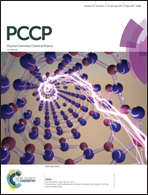Control and formation mechanism of extended nanochannel geometry in colloidal mesoporous silica particles†
Abstract
A large class of colloidal multi-micron mesoporous silica particles have well-defined cylindrical nanopores, nanochannels which self-assembled in the templated sol–gel process. These particles are of broad interest in photonics, for timed drug release, enzyme stabilization, separation and filtration technologies, catalysis, etc. Although the pore geometry and mechanism of pore formation of such particles has been widely investigated at the nanoscale, their pore geometry and its formation mechanism at a larger (extended) scale is still under debate. The extended geometry of nanochannels is paramount for all aforementioned applications because it defines accessibility of nanochannels, and subsequently, kinetics of interaction of the nanochannel content with the particle surrounding. Here we present both experimental and theoretical investigation of the extended geometry and its formation mechanism in colloidal multi-micron mesoporous silica particles. We demonstrate that disordered (and consequently, well accessible) nanochannels in the initially formed colloidal particles gradually align and form extended self-sealed channels. This knowledge allows to control the percentage of disordered versus self-sealed nanochannels, which defines accessibility of nanochannels in such particles. We further show that the observed aligning the channels is in agreement with theory; it is thermodynamically favored as it decreases the Gibbs free energy of the particles. Besides the practical use of the obtained results, developing a fundamental understanding of the mechanisms of morphogenesis of complex geometry of nanopores will open doors to efficient and controllable synthesis that will, in turn, further fuel the practical utilization of these particles.



 Please wait while we load your content...
Please wait while we load your content...